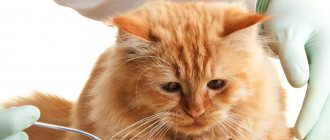Method 1: Add to food
Many owners try to “trick” the cat by slipping it a tablet of food. If the drug is in its entirety, then most likely the animal will spit it out or leave it in a bowl, and safely eat the rest. The solution may be to grind the medicine to a powder state. In addition, two conditions must be met:
- wait until the cat is very hungry (this will slightly dull its taste buds, at least for the first few seconds);
- mix the powder with a small amount of food (after satisfying your hunger with the first portions, your mustachioed friend can leave some of the medicine in the bowl).
Attention: not all medications can be taken with food!
Taking a tablet in food is the most cunning way, but it is not suitable for all medications.
Step-by-step procedure
If this is your first time giving your cat a pill, you need to have at least a rough idea of how this procedure goes. It is advisable that you have an assistant who carefully but firmly holds the cat. Later, after acquiring a certain skill, you will learn to give medicine to your cat without outside help.
First stage: preparation
Wait until the cat is in a calm mood. Caress her and calm her down. Ideally, the animal should be sleepy - then it will resist less.
If your pet has a temperament, wrap it in a thick towel - this way you will avoid scratches and even bites. Scratches are not so bad, but bites are very painful and take a long time to heal.
Open the tablet away from the cat so that it does not become nervous beforehand. Don't prepare in front of her.
Stage two: medication administration
Carefully open the cat's mouth and place the drug there. Make sure the animal swallows it. If your cat keeps spitting out liquid medicine, adjust it to allow for spillage, that is, give a little more than the veterinarian prescribed. The cat will swallow some of it, and some will have to be wiped off.
Third stage: removing aftertaste
Don't let your cat go right away; she may need help. If the drug was in solid form, pat the animal's throat and give some water.
Bitter suspensions and liquids cause severe salivation. In this case, you can give the cat sweetened water to remove the bitterness. Not all drugs can be used for this procedure, so consult a specialist in advance.
You definitely shouldn’t give treats: you can do that later. It is better to distract the cat by playing or leave him alone - perhaps he will want to wash himself or lie down.
Method 2. Give in powder
Most cats are very sensitive to foreign substances in their food and refuse to eat, even going on hunger strike. If this is your case, then try crushing the tablet into a powder and then pouring it into the cat's mouth.
Of course, there is no need to wait for the voluntary opening of the mouth - just place your palm on the pet’s head and squeeze the cheekbones on both sides (from the side of the molars). The animal will reflexively open its mouth, at this moment you need to quickly pour the powder deeper, close its mouth, and hold for 2-3 seconds.
There was something wrong with this food, I'm not happy!
Using a blanket
The cat must be wrapped in a blanket, rug or large towel in order to prevent it from moving and to prevent it from being injured by its claws or bitten. Having wrapped your pet, you need to secure it: squeeze it between your legs, kneeling down. Place one hand on the animal's head so that the thumb and index finger are placed on the cat's cheekbones, closer to the mouth. When you press on the cheekbones, the mouth will open slightly and you can put the necessary medicine there.
Typically, drugs are available in liquid or solid form:
- When you use a liquid medicine that is in a syringe without a needle, then the mouth should be opened only a little so that the medicine does not spill out.
- If you need to give a pill to your pet, you will have to open its mouth wide. The medicine must be pushed deep into the mouth so that the cat cannot spit it out, and the animal must not be allowed to open its mouth until it swallows the tablet. If your pet holds the medicine in his mouth, you should blow a little into his nostrils, in this way you will trigger the swallowing reflex.
Give your cat something to drink after she swallows the tablet.
Method 3. Dissolve the tablet in liquid
A cat may spit out a tablet in powder form, although partially, so it is better to first dissolve the powder in a small amount of liquid. You should not add it to drinking water or milk; just dissolve it in 5-7 ml of regular water.
In liquid form, the medicine can be given from a spoon by opening the cat's mouth in the manner described in the previous paragraph. Or draw it into a clean syringe (without a needle), insert the nozzle of the syringe into the side of the mouth between the molars and pour in the contents.
What is important to consider when giving your pet medication?
Giving tablets, capsules, powders and mixtures seems much easier than giving a cat an injection. In reality, everything is not so simple. A cute pet will definitely remind you that it has teeth and claws.
Giving medications orally (orally through the mouth) must be done correctly:
The best position for administering the drug is when the animal is sitting or in the sphinx position. This reduces the risk of medications entering the respiratory tract. Crushed pills and powders should not be poured dry into the animal’s mouth.
High risk of suffocation. It’s a good idea to ask your veterinarian whether a certain drug can be given with food, dissolved in a liquid, or ground into powder. It is important to monitor the dosage. Especially in kittens, who are often prescribed a certain proportion of one tablet. It is strictly forbidden to give liquid medicine to cats lying on their back. When a cat is given a bitter or sour drug, foam may form in the mouth and excessive salivation may occur.
It's not critical. But next time it is better to choose a different method.
You cannot give your pet suspensions, solutions, dragees, capsules, syrups, mixtures on your own in the following cases:
- vomit;
- difficulty breathing;
- damaged neck muscles and skull bones;
- intestinal obstruction, constipation for many days, when there is a risk of complete blockage of the intestine or when a foreign body is suspected;
- painful lesions in the oral cavity.
Method 4. Put it in the mouth
There are medications that cannot be crushed or given in parts. There is only one way out here - just open the pet’s mouth and put a pill in it. What actions will be required for the cat to reflexively open its jaws is described above. It should only be added that the tablet should be placed as far as possible on the root of the tongue to stimulate the swallowing reflex. Afterwards, also close the pet’s mouth and hold it in this position for 2-3 seconds.
How rough!
Recommendations from veterinarians
Taking medications is in any case stressful for four-legged pets. Therefore, many owners remember previous illnesses with fear, because cats actively show aggression and categorically refuse medications. However, veterinarians give owners the necessary advice that will help greatly simplify this procedure.
- Do not yell at your pet under any circumstances, as this will not make the process any easier. The fact is that animals do not understand human language, and he will not understand you anyway; from such actions he will only experience even more stress.
- Taking pills out of the package in the presence of a cat is not the best thing to do. After all, cats remember the actions of their owner, and they can remember that the last time he was severely tormented after this. Therefore, he will try to hide from you better.
- Cases of injury cannot be excluded, because your cat may bite or scratch you. Therefore, we recommend that you keep a piece of cotton wool soaked in hydrogen peroxide at the ready.
- If you need to regularly give tablets to your pets, then try to do it confidently and quickly. Then the cat will get used to such procedures, and each time he will react calmer.
- If you can’t persuade your cat to take a vitamin, then you should talk to your veterinarian. After all, you can simply choose a different way of taking medications. After all, they can be produced in the form of pastes, suspensions or solution for injection.
- Remember that your pet's comfort is important, so we recommend placing your pet on a table. For comfort, you should lay a soft blanket on it.
Getting a cat to take medicine is not that easy in reality. If you read the article carefully, then you know how to give a pill to a cat if he spits it out. Whatever method you choose, the main thing is calm and self-confidence. The cat will sense your mood and will resist less. Good health to you and your pet!
Don't forget to leave a comment which method worked for you?
Method 5. Use a tablet dispenser
A special device - a tablet dispenser, or piller - will help make the task of swallowing medicine easier. In appearance and principle of operation, it resembles a syringe, but instead of a needle it has a long soft tube. To give a pill to a cat, simply insert the medicine into the tip of the tube, open the animal's mouth, and then press the plunger. Under the influence of air, the drug will reach its destination.
Note: such a device is sold at a veterinary pharmacy or pet store. However, you can make it yourself by cutting off the bottom of a plastic syringe of the required diameter.
We use a tablet dispenser
A very obedient cat who loves pills
Emotional mood
One of the mandatory conditions for treatment is to take care of the animal’s emotional state in advance. Before giving a pill to a kitten or adult pet, try to behave calmly and not be nervous. You can simply talk to the animal - the owner’s voice has a calming effect. It is not recommended to chase your pet throughout the apartment; it is better to wait until it comes on its own. It is prohibited to carry out the procedure near the sleeping area, tray or food bowl. Subsequently, the animal will associate them with unpleasant manipulations.
Another requirement is not to call the cat to take the medicine. The animal may decide that the owners are going to feed them, play or just pet them. In the future, the pets will refuse to respond to their owners’ calls.
You should not force an animal to take medicine, especially if a long course of treatment is prescribed. Each time it becomes more and more problematic to give a pill to a cat, so it is recommended to perform manipulations only on a pet that is in a state of calm. If your pet behaves aggressively or restlessly, it is better to postpone taking the drug for a while and repeat after an hour and a half.
X
How to get a cat to swallow a pill
Some mustachioed four-legged animals manage to hold the tablet in their mouths for some time and then spit it out, therefore, having closed the cat’s jaws, you need to make several stroking movements along the esophagus - from top to bottom along the front surface of the animal’s neck. Another way is to blow into your pet's nose. This will also lead to a swallowing reflex. You should definitely check the result by examining the sly man’s oral cavity.
After the treatment is successfully completed, do not forget to caress your pet and please him with something tasty. If for some reason it is not possible to give the medicine, you need to contact a veterinary clinic.
Morally preparing the cat for the procedure
Preparation consists of securing the animal so that it does not injure you during the procedure. This can be done in different ways.
One option: wrap the cat in a blanket or thick blanket, similar to swaddling a baby. It is possible, especially if long-term treatment is required, to sew something like a cone from dense fabric with a hole in the upper part - only the animal’s head should fit through it.
Such a cone is put on a cat. Her paws are fixed inside, and her head remains free.
Another option: sit the cat on a soft pillow. In this case, you will have to hold the animal with your hands by the front legs. And the hind legs will “sink” into the pillow and the cat will not be able to scratch you with them.
The choice of how to restrict the animal's movements is up to you. The main thing is that it should not cause pain to your pet. It is better to give medicine together: alone you will not be able to handle both holding the cat and giving it medicine.
Second method
Fortunately, modern veterinary medicine has made great strides forward, therefore, most cat diseases are treatable and treatable, of course, if you contact a specialist in time and follow all his recommendations regarding taking the necessary medications. Depending on the pet’s diagnosis, its condition, age, body weight, and a number of associated factors, the veterinarian may prescribe tablets, powders, injections (find out here), IVs, medications in the form of suspensions, suppositories... And here I would like Once again draw the attention of cat owners to the fact that
Self-medicating your pet is too dangerous. Likewise, you should not try to replace taking pills with injections or vice versa. Seek further advice from a specialist and explain your situation; he will certainly be able to choose the optimal treatment regimen for your pet. If there is no alternative, you will have to follow his recommendations if you want to save your cat’s health.
Until the medicine enters your pet’s body, it is useless, even if it lies on the nightstand in your room. Therefore, your main task is to give it to the cat. Get ready for the fact that the animal may not agree with your intentions to treat it, therefore, you may encounter protest in the form of hissing, scratching (special ones can protect against claws), bites... The cat may even try to spit out the medicine.
If your cat has been prescribed pills, but they are odorless, and the animal refuses to take them on its own, you can place the pill (if its size allows) inside a piece of butter or your cat's favorite treat, and freeze it all in the freezer. Then, you can take a piece of food with the tablet out of the refrigerator, let it thaw a little and offer it to your cat to eat. Watch your pet carefully so that he doesn’t see through you and spit out the medicine.
We suggest you read: Is it possible to give activated charcoal to a cat: dosage. How to help a cat with poisoning How long can a cat be given activated charcoal
However, not all tablets can be frozen and mixed with food (read the instructions for the drug about this); some must be taken before or after meals. In order for the cat to swallow the tablet, you will need to pick it up, carefully open its mouth, place your index finger and thumb behind its fangs, lift the animal's head up and put the tablet on its tongue.
If the veterinarian has prescribed a liquid form of medicine for your pet - as a rule, these are syrups or suspensions, and they are most often prescribed to kittens, then to administer the medicine into the cat’s body, you should carry out the same steps that we described in the paragraph above - hold the cat’s head horizontally so that the medicine, which is more convenient to give not from a spoon, but from a special dispenser syringe (without a needle, of course), does not get into the respiratory tract.
The syringe is carefully inserted behind the animal's cheek - you should not try to forcefully open the cat's mouth, you will only scare the pet and may accidentally cause him pain, it should be between the teeth and the cheek - this is the most optimal and convenient position for administering the medicine... It is worth pouring the liquid medicine in small amounts doses, and if the cat suddenly starts coughing (that is), then it is better to stop administering the medicine and give her the opportunity to clear her throat and calm down. After the cat has calmed down - your kind words and stroking helped her with this - you can continue giving her liquid medicine.
If the treatment involves the external use of medications - ointments or creams, then before applying them to the animal’s skin (and the ointment and cream are applied to the skin, not to the fur), the areas to be applied should be carefully trimmed (the hair should be as short as possible length) and rinse.
The ointment itself should be applied in a thin layer and allowed to be absorbed into the skin. However, here I would like to draw the attention of cat owners to their habit of licking themselves thoroughly. Some compositions of ointments and creams are not intended for internal entry into the animal’s body, as they can cause serious complications.
Health problems affect not only people, but also pets. When a cat gets sick, the owner goes to the veterinarian and finds out that the pet will now have to tinker with it. Let's look at how to give a cat a pill and stay alive.
There are several ways to give a cat a pill. The simplest methods concern those drugs that can be crushed, dissolved and mixed. Therefore, before feeding your animal medication, consult your veterinarian. The doctor will give instructions as to whether a particular drug tolerates such manipulations.
If you can crush the tablet and do other things with it, you're in luck. This method of feeding it to the cat is the least energy-consuming. So, how can you treat your pet with a healing pill without unnecessary movements:
- Trick the animal. Take a tablespoon of sour cream and mix with the powdered pill. If the tablet does not initially have a bitter taste or a pungent odor (and this happens extremely rarely), you will be able to outwit the mustachioed one. After making the mixture, take the cat on your lap and try to act as calmly as possible. Apply large strokes of sour cream to the cat's nose and talk to him in a normal tone. Hypnotized by the unprecedented generosity, the cat will not notice the catch and will take the drug under the guise of a treat.
- Ask your veterinarian if there is an analogue of the required drug in a different form of release. Admit to the doctor that the claws scare you and it is easier for you to use a suspension or drops. If the manufacturer has provided for such a case, then you can buy the drug in liquid form at most veterinary pharmacies.
- The simplest way, which can somewhat undermine your authority in yellow eyes, is to simply give a pill. You need to catch the animal and sit it on the table in front of you. The success of the result directly depends on your calmness, so don’t panic. Fix the seated cat with one hand or with the help of an assistant. With your free hand, open the animal's mouth by pressing on the sides. Place the tablet on the root and close your mouth. Next, stroke the cat’s throat until he decides to swallow the pill.
If it is difficult to restrain your cat, or you have to do it without outside help, try swaddling your pet in a blanket. Several layers of fluff stop even the most violent “patients”. A roll with a cat inside is easier to fix.
Place the roll on the bed and press it with your forearm. This way, your palms will be free, which will allow one of them to open its mouth using the method described above, and the second to place the tablet on the tongue.
To help in this matter, a very convenient and easy-to-use device has been invented, called a piller or tablet dispenser. It allows you to significantly simplify this unpleasant procedure, as well as quickly and accurately give the kitten any tablet or capsule.
Using this device is very simple: the tablet is inserted into the rubber tip of the piller and placed in the animal’s open mouth (on the root of the tongue), then you need to press the piston and push out the medicine, close the mouth and stroke the throat, encouraging swallowing. Ready! Everything is quick and easy; you can purchase such a tool at any pet store.
You can also give the tablet to a kitten without using any equipment. If you have to do this for the first time, then it won’t hurt to have someone from your family participate in this process. The main task is to secure the pet well so that it does not have a chance to break free and run away.
You can place the kitten on a table or any higher place (so you don’t have to bend over) or sit on the floor on your lap. It is necessary to place the animal with its back to itself, so it will not be able to escape, you can also squeeze it with your knees (just not too tightly). Prepare the tablet in advance and hold it in your right hand.
The left hand lies on top of the pet’s head; you need to wrap two fingers around the muzzle on both sides and gently press behind the cheeks on the space between the jaws. This will force the cat to open its mouth; you need to lift its head up and place the tablet on the root of its tongue. Immediately close your mouth and make a few stroking movements along the throat from top to bottom to help swallow the tablet.
We invite you to read: Antihistamines for cats: a brief overview
If the animal behaves too aggressively, breaks out and bites, and you can’t give the kitten a pill, you can use one trick. To do this you will need a towel, or blanket, or any thick fabric. A kitten or adult cat is wrapped in it so that only the head remains outside. This bundle can be placed on your lap or on your left hand, so that the muzzle is facing the owner.
Of course, all this time the kitten will be trying to free itself from captivity, so everything needs to be done quickly. The next task is to open the pet's mouth. We lift his head with one hand and press with our finger in the place behind the fangs - this will force him to open his mouth. Now you need to quickly place the tablet there, preferably further and deeper - at the root of the tongue. We make several stroking movements on the throat and check whether the tablet is swallowed or not.
This method is guaranteed to be very disliked by your pet, because cats hate it when something is done to them against their will. On the other hand, this way you can quickly and conveniently give any pill, and also protect yourself from the sharp claws of an animal. Regardless of which method is chosen to give the pill to a kitten or cat, it is not always possible to do it the first time. Most often, the second or third attempt ends successfully. In this, as in any matter, practice and skill are needed.
Applying a treat
Medicines used for the prevention and treatment of various pathologies have different properties.
The fact is that some pills should be absorbed only in the intestines, bypassing the acidic environment of the stomach. Only then will they be effective and provide the necessary therapeutic effect. Such tablets are usually produced in the form of capsules. The outer layer of this form of medicine protects the main active ingredient from destruction in the stomach. Before giving medication to a cat, the owner should consult a veterinarian about the possibility of mixing the drug with food. Many medications must be given on an empty stomach. You can also find out whether the tablet can be given with food in the instructions.
The tablet should be divided into 4 - 6 small portions and disguised in pieces of sausage, cheese or other cat's favorite food. If the drug does not lose its properties, then the tablet can be ground into powder and mixed with your pet’s favorite treat. Most often, this trick works for animals that are not picky about food.











